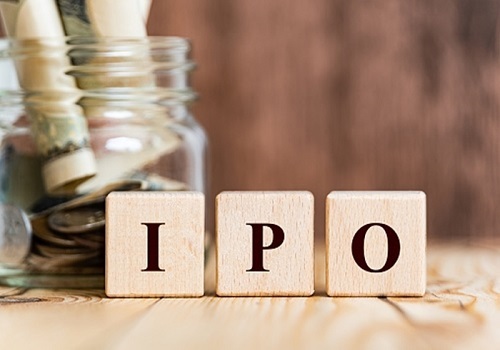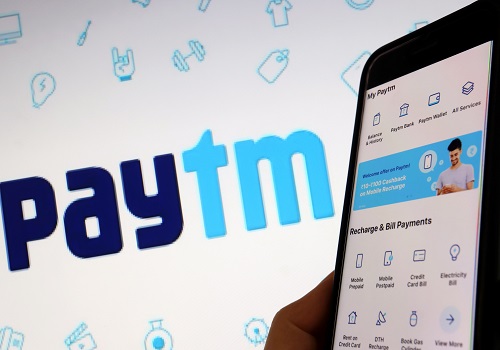One 97 Communications coming with an IPO to raise upto Rs 18,916 crore

Follow us Now on Telegram ! Get daily 10 - 12 important updates on Business, Finance and Investment. Join our Telegram Channel
One 97 Communications
-
One 97 Communications is coming out with a 100% book building; initial public offering (IPO) of 8,79,80,769 shares of Rs 1 each in a price band Rs 2080- 2150 per equity share.
-
Not less than 75% of the issue will be allocated to Qualified Institutional Buyers (QIBs), including 5% to the mutual funds. Further, not more than 10% of the issue will be available for the non-institutional bidders and the remaining 15% for the retail investors.
-
The issue will open for subscription on November 08, 2021 and will close on November 10, 2021.
-
The shares will be listed on BSE as well as NSE.
-
The face value of the share is Rs 1 and is priced 2080 times of its face value on the lower side and 2150 times on the higher side.
-
Book running lead manager to the issue are Morgan Stanley India Company , Goldman Sachs(India) Securities , Axis Capital , ICICI Securities, J.P.Morgan India, Citigroup Global Markets India and HDFC Bank.
-
Compliance Officer for the issue is Amit Khera.
Profile of the company
The company is India’s leading digital ecosystem for consumers and merchants as it has built the largest payments platform in India based on the number of consumers, number of merchants, number of transactions and revenue. It offered payment services, commerce and cloud services, and financial services to 337 million registered consumers and over 21.8 million registered merchants. Its two-sided (consumer and merchant) ecosystem enables commerce, and provides access to financial services through its financial institution partners, by leveraging technology to improve the lives of its consumers and help its merchants grow their businesses.
The company launched Paytm in 2009, as a ‘mobile-first’ digital payments platform to enable cashless payments for Indians, giving them the power to make payments from their mobile phones. Starting with bill payments and mobile top-ups as the first use cases, and Paytm Wallet as the first Paytm Payment Instrument, it has built the largest payments platform in India based on the number of consumers, number of merchants, number of transactions and revenue as of March 31, 2021. Paytm is available across the country with ‘Paytm karo’ (i.e. use Paytm) evolving into a verb for hundreds of millions of Indian consumers, shopkeepers, merchants and small businesses.
The Paytm app is a payments-led super-app, through which it offer its consumers innovative and intuitive digital products and services. It offer its consumers a wide selection of payment options on the Paytm app, which include (i) Paytm Payment Instruments, which allow them to use digital wallets, sub-wallets, bank accounts, buy-now-pay-later and wealth management accounts and (ii) major third-party instruments, such as debit and credit cards and net banking. On its app, it enable its consumers to transact at in-store merchants, pay their bills, make mobile top-ups, transfer money digitally, create and manage their Paytm Payment Instruments, check linked account balances, service city challans and municipal payments, buy travel and entertainment tickets, play games online, access digital banking services, borrow money, buy insurance, make investments and more.
Proceed is being used for:
-
Growing and strengthening its Paytm ecosystem, including through acquisition and retention of consumers and merchants and providing them with greater access to technology and financial services.
-
Investing in new business initiatives, acquisitions and strategic partnerships.
-
General corporate purposes.
Industry overview
Indian payment system has evolved significantly in since 1980. For a long time cheque clearing systems dominated the payment landscape in India. The cheque clearing system underwent significant transition from Magnetic Ink Character Recognition (MICR) in 1980’s to the cheque truncation system first introduced in 2008. RBI has recently released a framework to authorize the setting up of New Umbrella Entity (NUE) for retail payments. As of now NPCI is the sole organization with a variety of innovative payment systems. The new umbrella entities set up will be able to set up and manage new payment systems such as ATMs, white label PoS, remittance services. It will also help fulfil objectives of transparency, efficiency in payment systems, decongest NPCI and foster innovation.
Digital payments have been growing steadily over time, however India continues to be cash driven economy. In FY 2021, digital payments market size by value stood at approximately $20 trillion with 43 billion transactions during the year. Consumers are rapidly switching to digital payments as it provides simple, safe and convenient ways to transfer money across accounts. Similarly, for merchants, acceptance of payments in digital form has increased significantly. Moreover, merchants have taken up digitization beyond merely accepting digital payments, digitization is helping them in other aspects of their business like credit, invoicing, maintaining ledger/accost, bookkeeping etc. helping their business to grow further.
Financial services system plays a crucial role in the economic development of a country. It allows efficient flow of savings and investments, managing credit requirement of businesses. Financial services have the ability to give support for growth of a new business and access to capital. India is significantly under penetrated across various financial services products which provides huge opportunity for players to grow across various sub segments such as lending, insurance, wealth management etc. India’s formal credit lending models require extensive documentation, active bank accounts and a steady source of income, with decent credit history at the very least. The journey from origination, to actual loan amount disbursal can take up to days. Only a fraction of MSMEs and population is able to meet all the criteria to avail credit from traditional financial institutions.
Pros and strengths
Trusted brand, scale and reach: The company’s brand stands for Trust, Convenience and Transparency. Paytm is available across the country with ‘Paytm karo’ (i.e. “use Paytm”) evolving into a verb for hundreds of millions of Indian consumers, shopkeepers, merchants and small businesses. An indication of trust in its brand is that Paytm has the highest top of mind recall and unaided awareness among merchants compared to other digital payment platforms, which represents the strength of its brand. As per the Kantar BrandZ India 2020 Report, the 'Paytm' brand is India's most valuable payments brand, with a brand value of $6.3 billion, and Paytm remains the easiest way to transact across multiple methods. The company’s payments platform, with a wide selection of daily life use cases and payment instruments, provides it with large scale and reach. It had 337 million registered consumers and over 21.8 million registered merchants as of June 30, 2021. Its scale and reach help it distribute new products and services across all of its businesses faster and in a cost efficient manner.
Insights of Indian consumers and merchants: The company has developed unparalleled insights into the way Indian consumers spend and save, and the way merchants operate their businesses. Each transaction on its ecosystem provides insights that help it improve personalization for its consumers and merchants and create products and services addressing their needs. This personalization in turn improves consumer and merchant experience and the quality of their engagement on its ecosystem.
Product and technology DNA: The company had an average engineering and technology team of 2,550 members and 2,471 members in FY 2021 and in the three months ended June 30, 2021. Its technology stack is built ground up and integrated across all aspects of its ecosystem. Building technology itself and innovating at each layer of the technology stack, allows it to ensure that it is able to launch products and services quickly, build various features, offer integrated and synergistic products, ensure system stability, handle large scale and provide highest success rates. This significantly improves the experience of its consumers and merchants on its ecosystem.
Leadership and culture: The company’s mission and focus on solving big problems, and the expanse of its ecosystem makes it an attractive place for best-in-class leaders who bring a combination of domain expertise and a hunger to redefine the way Indians access payments, commerce, cloud and financial services products. This, combined with its culture of empowerment, helps it to grow multiple large businesses at the same time. Its values and culture guide its approach to the market, and how it does business, and provides it a long-term and sustainable advantage. Its focus on transparency defines its products, and also helps it build trust with regulators and other stakeholders. Its culture of innovation allows it to solve big problems using technology by developing pioneering products.
Risks and concerns
Derive majority of revenue from payment services: The company derives a majority of revenue from transaction fees it collect from merchants for its payment services. The company’s efforts to expand its payment services depends on among other things, its ability to broaden the scope of the products and services it offer, develop new technologies, enhance the functionality of its products and services and respond to the needs of its merchants and consumers. Its failure to broaden the scope of payments services that are attractive may inhibit the growth its business, as well as increase the vulnerability of its core payments business to competitors. Further, its revenue may also be affected by its service mix. It generate higher fees from the use of certain payment instruments compared to others.
Rely on third-parties for certain aspects of business: The company depends on third-party service providers for certain services, such as financial, technology, and other services to support its operations, including credit ratings and reporting, cloud-based data storage, data centers and other IT solutions, and payment processing. In FY 2019, FY 2020, FY 2021 and in the first quarter of FY 22, its top ten suppliers for such respective years/quarter by consolidated restated third party expense contributed 56.7%, 56.2%, 61.2% and 69.8%, respectively, of its total consolidated restated expenses towards third party. It also outsources a portion of its services, such as, customer care services, deployment of QR codes and sale of hardware devices, among others. Its success depends on its ability to manage various service providers to provide reliable and satisfactory services to consumers on its platform. Its operations and business could be adversely affect its outsourcing service providers face any operational or system interruptions.
Depends on ability to generate repeat use and increased transaction volume: If the company is not able to continue to grow its consumer base, it will not be able to continue to grow its merchant network or its business. Its ability to retain and grow its consumer base depends on the willingness of consumers to use its platforms, products and services. The attractiveness of its platforms to consumers depends upon, among other things: the number and variety of merchants and the mix of products and services available through its platforms; its brand and reputation; consumer experience and satisfaction; consumer trust and perception of its solutions; technological innovation; and products and services offered by competitors. Its marketing efforts currently include digital and print marketing, sponsorships for sporting events and promotional discounts and offers to its merchants and consumers.
Rely on financial institutions partners to provide financial services and products: The company partner with financial institutions partners to provide financial services and products to consumers and merchants. Its financial institutions partners include commercial banks, mutual fund managers, insurance companies, securities firms and other licensed financial institutions. Its success depends on its ability to maintain a mutually beneficial partnership with these financial institutions. Its financial institutions partners may determine to reach and acquire consumers directly instead of partnering with it; may renegotiate commercial terms of the fee arrangements it has with them; may become unwilling to offer products and services on its platforms; and may reduce or cease their cooperation with it and therefore expose it to greater partner concentration risk or ultimately lead to its inability to satisfy demand from consumers.
Outlook
Incorporated in 2000, One 97 Communications is India's leading digital ecosystem for consumers as well as merchants. It offers products and services across ‘payment services’, ‘commerce and cloud services’ and ‘financial services’. Its products and services are carefully developed to address large markets, and in areas where the consumers and merchants are underserved. In 2009, the company launched the first digital mobile payment platform, ‘Paytm App’ to offer cashless payment services to customers and now, it became India's largest payment platform and the most valuable payments brand with a total brand value of $6.3 billion as per Kantar BrandZ India 2020 Report. The app enables customers to do cashless transactions at stores, top-up mobile phones, online money transfers, pay bills, access digital banking services, purchase tickets, play games online, buy insurance, make investments, and more. However, merchants can use the platform for advertising, online payment solutions, offering products to customers, and loyalty solutions. On the concern side, the company’s business could be impacted by the failure of telecommunications network operators to provide it with the requisite bandwidth which could also interfere with the speed and availability of its platform, as well as by breakdowns at the level of its internet service providers. Besides, the company may face pricing pressures from competitors. Some potential competitors are able to offer lower prices to merchants for similar products and services by cross-subsidizing their payments services through other services they offer.
The issue has been offered in a price band of Rs 2080-2150 per equity share. The aggregate size of the offer is around Rs 18,300 crore to Rs 18,916 crore based on lower and upper price band respectively. On the performance front, the company’s revenue from operations decreased by 14.6% to Rs 28,024 million in FY 2021 from Rs 32,808 million in FY 2020. Its restated loss for FY 2021 declined by 42.2% to Rs 17,010 million from a loss of Rs 29,424 million for FY 2020. The company will continue to grow its consumer and merchant base, adhering to its mission which is to bring half a billion Indians into the mainstream economy. It expects this to include tens of millions of small Indian businesses and merchants. It will continue to focus on bringing together various pieces of its ecosystem to build innovative products for its consumers, which could take the form of increasing seamlessness between (i) consumers and merchants, (ii) various use cases and, (iii) various payment instruments. It also intends to continue making access to technology easy and affordable for its merchants by identifying merchant problems that can be solved using technology.
























